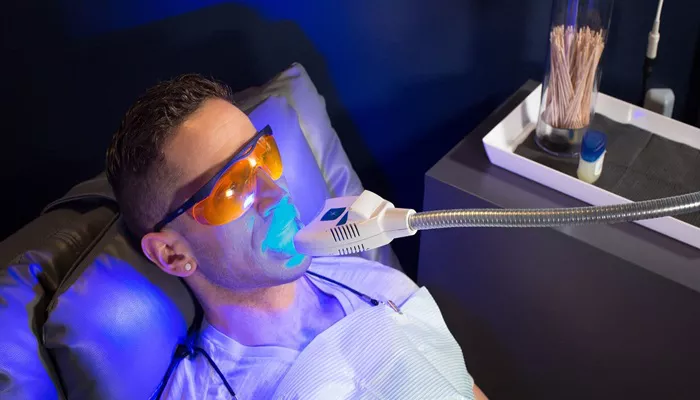Teeth whitening is a common cosmetic dental procedure aimed at enhancing the brightness of teeth and improving smiles.
Among the various methods available, blue light teeth whitening has gained significant popularity for its effectiveness and relatively quick results. This article explores how blue light teeth whitening works, detailing its specific mechanisms, benefits, and considerations.
What Is Blue Light Teeth Whitening?
Blue light teeth whitening is a professional whitening technique used to lighten the color of the teeth. This method involves the application of a whitening gel containing hydrogen peroxide or carbamide peroxide, which is then activated by a specialized blue light. The combination of the whitening agent and the blue light accelerates the whitening process, leading to faster and more effective results compared to traditional whitening methods.
The Popularity of Blue Light Whitening
Many people choose blue light teeth whitening because it is less time-consuming than other whitening options. Sessions typically last about 30 to 60 minutes, making it convenient for individuals with busy schedules. Additionally, the visible results after just one session often lead to higher patient satisfaction.
The Mechanism of Action
The process of blue light teeth whitening can be broken down into several key steps:
1. Application of the Whitening Gel
The whitening procedure begins with the application of a specially formulated whitening gel on the surface of the teeth.
This gel contains active ingredients, usually hydrogen peroxide or carbamide peroxide, which are responsible for the whitening effect. These compounds penetrate the enamel and dentin layers of the teeth, breaking down stains and discoloration.
2. Activation by Blue Light
Once the whitening gel is applied, a blue LED light is directed onto the teeth. This light typically emits wavelengths between 400 to 500 nanometers, which are ideal for activating the hydrogen peroxide molecules in the whitening gel. The light does not produce heat, making the procedure comfortable for patients.
3. Chemical Reaction
The blue light triggers a chemical reaction in the whitening gel. The activated hydrogen peroxide or carbamide peroxide breaks down into water and oxygen. This reaction results in the release of free radicals that penetrate the tooth structure, breaking apart complex stain molecules.
SEE ALSO: How to Keep Teeth Dry When Whitening?
4. Stain Removal
As the stain molecules break down, they become smaller and less visible. This process can effectively lighten various types of stains, including those caused by:
Food and beverages: Coffee, tea, red wine, and certain fruits can contribute to discoloration.
Tobacco: Smoking or chewing tobacco can lead to significant staining over time.
Medications: Certain medications, like tetracycline, can cause intrinsic stains that are harder to remove.
5. Final Rinse and Results
After the treatment, the whitening gel is removed, and the teeth are rinsed. Patients often notice an immediate improvement in the brightness of their teeth, with many reporting several shades lighter.
The final results may continue to improve for up to 48 hours post-treatment as the teeth continue to respond to the whitening agents.
Benefits of Blue Light Teeth Whitening
Blue light teeth whitening offers several advantages:
1. Speed and Efficiency
One of the most significant benefits of this method is the speed at which results can be achieved. Many patients see a noticeable difference in their tooth color after just one session.
2. Comfort
The procedure is generally comfortable, with minimal to no sensitivity reported during or after treatment. The use of LED lights is also safer than older UV light methods, which could potentially harm the gums or surrounding tissues.
3. Customization
Dentists can customize the concentration of the whitening gel based on the patient’s specific needs and desired results.
This personalization ensures that each patient receives the most effective treatment for their unique dental condition.
4. Professional Supervision
Undergoing blue light teeth whitening at a dental office allows for professional supervision. Dentists can monitor the procedure and make adjustments if necessary, ensuring patient safety and optimal outcomes.
Considerations And Potential Risks
While blue light teeth whitening is generally safe, there are a few considerations to keep in mind:
1. Tooth Sensitivity
Some patients may experience temporary tooth sensitivity following the procedure. This sensitivity typically subsides within a few hours or days. Dentists may recommend desensitizing toothpaste to help alleviate discomfort.
2. Gum Irritation
If the whitening gel comes into contact with the gums, it can cause temporary irritation. Dentists take precautions to protect the gums during the procedure, but it’s essential for patients to communicate any discomfort.
3. Results May Vary
The effectiveness of blue light teeth whitening can vary based on individual factors, including the type and severity of stains, the natural color of the teeth, and adherence to post-treatment care. Patients should have realistic expectations and understand that multiple sessions may be necessary for optimal results.
Post-Treatment Care
To maintain the results of blue light teeth whitening, patients should follow these post-treatment care tips:
1. Avoid Staining Foods and Drinks
After whitening, teeth can be more susceptible to staining. It is advisable to avoid foods and beverages that may cause discoloration for at least 48 hours. This includes coffee, tea, red wine, and dark-colored sauces.
2. Maintain Oral Hygiene
Good oral hygiene practices, including regular brushing and flossing, will help prolong the effects of the whitening treatment. Using a whitening toothpaste can also be beneficial.
3. Regular Dental Check-ups
Regular visits to the dentist for cleanings and check-ups are essential for maintaining overall oral health and the results of teeth whitening.
Conclusion
Blue light teeth whitening is an effective and popular method for achieving a brighter smile. By utilizing a combination of a specialized whitening gel and blue light activation, this technique offers quick results while ensuring patient comfort and safety. Understanding the mechanism behind blue light teeth whitening can help patients make informed decisions about their cosmetic dental options. As with any dental procedure, consulting with a dental professional is crucial to determine the best whitening method for individual needs.
Related topics:

